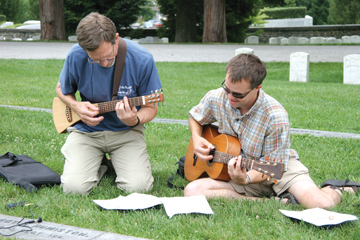Pitt’s Voices Across Time Institute Trains Educators to Teach With Music

Teachers Robert Tam (left) from Honolulu and Mark Dillon from Asheboro, N.C., participated in the 2006 Voices Across Time Institute. Here, they played a song at the grave of a Civil War soldier during a field trip to Gettysburg.
Twenty-five educators from as far away as Hawaii and Puerto Rico will converge on the University of Pittsburgh campus July 7 through Aug. 8 for the Voices Across Time Summer Institute for teachers—a program developed by Pitt’s Center for American Music that trains teachers how they can use American music as a tool to educate students at the elementary, middle, and high school levels.
Funded through the National Endowment for the Humanities, the institute has been held twice before at Pitt. Among the Voices Across Time faculty members are musicologists, historians, and performers who provide the teachers with materials and techniques they can use to weave American music into their existing curricula and as a primary source for teaching students the history of the nation. Past participants have reported a marked increase in the level of enthusiasm and performance among their students.
“The sound of history is missing from our classrooms,” says institute codirector Deane Root, Pitt professor of music and director and the Fletcher Hodges Jr. curator of the Center for American Music.
Root says the institute provides participants with musical examples to support their teaching, such as listening to the spiritual “Go Down, Moses” to help them better understand slavery. They may hear Woody Guthrie’s “This Land Is Your Land” as a representation of the American populist movement of the mid-20th century, and Bruce Springsteen’s “Philadelphia” may enlighten them about poverty and health care in urban centers.
Said one past Voices participant: “Songs are remarkable transmitters of culture and history. I will never again view songs as isolated expressions of musical creativity.”
Other Stories From This Issue
On the Freedom Road

Follow a group of Pitt students on the Returning to the Roots of Civil Rights bus tour, a nine-day, 2,300-mile journey crisscrossing five states.
Day 1: The Awakening
Day 2: Deep Impressions
Day 3: Music, Montgomery, and More
Day 4: Looking Back, Looking Forward
Day 5: Learning to Remember
Day 6: The Mountaintop
Day 7: Slavery and Beyond
Day 8: Lessons to Bring Home
Day 9: Final Lessons

